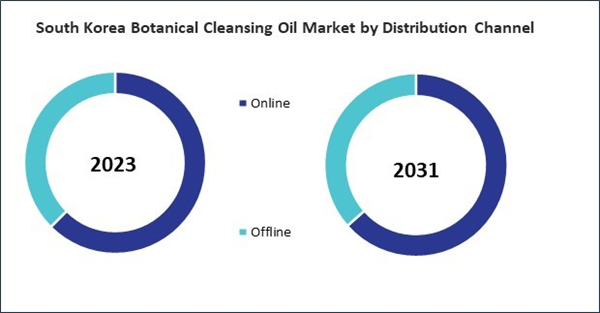The market for mixed skin types caters to individuals with a combination of oily and dry areas on their skin, requiring a balanced approach to skincare. These oils designed for mixed skin typically feature a blend of lightweight and nourishing oils to address both oily and dry areas effectively. Therefore, the India market consumed 136.75 tonnes of Botanical Cleansing Oil in Mixed Skin segment in the year 2023.
The China market dominated the Asia Pacific Botanical Cleansing Oil Market by Country in 2023, and would continue to be a dominant market till 2031; thereby, achieving a market value of $410.1 Million by 2031. The Japan market is registering a CAGR of 9.8% during (2024 - 2031). Additionally, The India market would showcase a CAGR of 11.1% during (2024 - 2031).
The widespread adoption of botanical cleansing oils reflects a paradigm shift in consumer preferences towards natural, gentle, and effective skincare solutions. Several factors contribute to the growing adoption of these oils. For instance, consumers are increasingly mindful of the ingredients they apply to their skin, seeking products formulated with natural, plant-based ingredients rather than synthetic chemicals.
Botanical cleansing oils, derived from plant extracts and essential oils, resonate with this preference for clean, green beauty, offering a gentle alternative to traditional cleansers. Unlike harsh cleansers that can leave the skin feeling dry and tight, these oils dissolve impurities, makeup, and excess sebum while maintaining the skin’s hydration levels, making them suitable for all skin types, including sensitive and dry skin.
With the growth of India’s premium personal care products industry, there is a heightened demand for high-quality skincare products. These oils, known for their natural ingredients and gentle formulations, cater to the preferences of discerning consumers seeking premium skincare solutions. Hence, the growing personal care industry and e-commerce sector in the region are driving the market’s growth.
Based on Distribution Channel, the market is segmented into Online and Offline. Based on Type, the market is segmented into Mixed Skin, Dry Skin, and Oily Skin. Based on countries, the market is segmented into China, Japan, India, South Korea, Australia, Malaysia, and Rest of Asia Pacific.
List of Key Companies Profiled
- Kao Corporation
- Unilever PLC
- L'Oreal S.A.
- Avon Products, Inc. (Natura &Co Holding S.A.)
- Johnson & Johnson
- Activist Skincare LLC
- The Procter and Gamble Company
- The Clorox Company
- The Colgate Palmolive Company
- COSRX, Inc. (Amorepacific Corporation)
Market Report Segmentation
By Distribution Channel (Volume, Tonnes, USD Billion, 2020-2031)- Online
- Offline
- Mixed Skin
- Dry Skin
- Oily Skin
- China
- Japan
- India
- South Korea
- Australia
- Malaysia
- Rest of Asia Pacific
Table of Contents
Companies Mentioned
- Kao Corporation
- Unilever PLC
- L'Oreal S.A.
- Avon Products, Inc. (Natura &Co Holding S.A.)
- Johnson & Johnson
- Activist Skincare LLC
- The Procter and Gamble Company
- The Clorox Company
- The Colgate Palmolive Company
- COSRX, Inc. (Amorepacific Corporation)
Methodology

LOADING...









